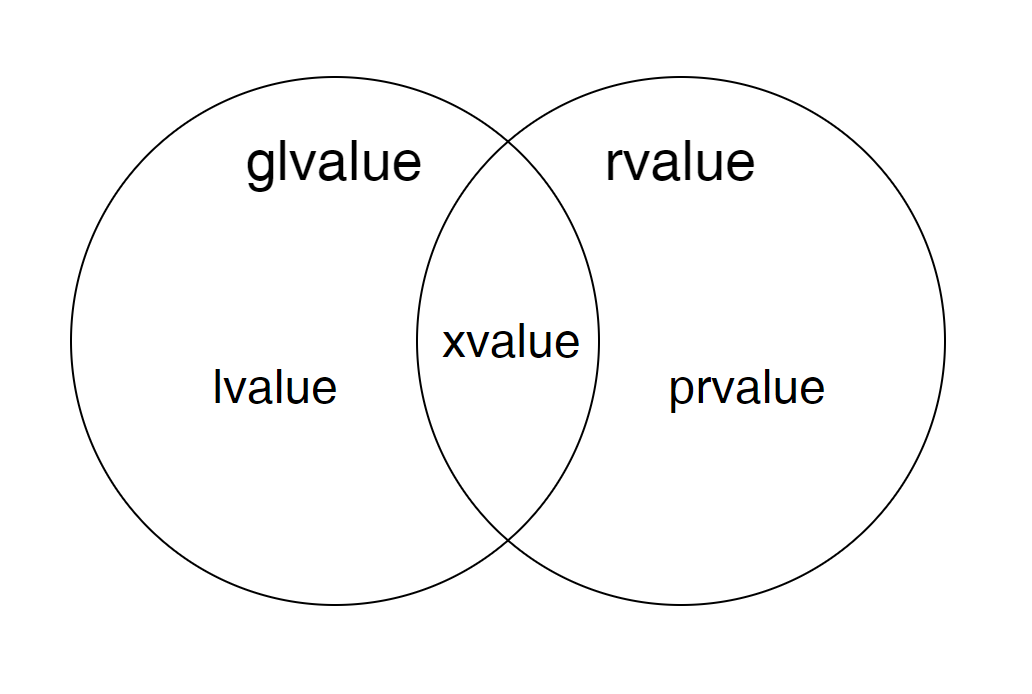值类型
正如之前博客中所提到的,C++中的表达式要么是左值,要么是右值。左值是可以获得地址的表达式,但是不能被移动,而右值是可以被移动的表达式,但是不能取地址。
如果细分值类型的话,我们前面提到的左值其实属于泛左值glvalue(generalizaed lvalue)。泛左值glvalue可以分为2种:左值lvalue、将亡值xvalue(eXpiring value)。而右值rvalue也可以分为2种:将亡值xvalue(eXpiring value)和纯右值prvalue(pure rvalue)。直接提出这些概念可能比较突兀,下面详细解释一下这些概念的意思:
- glvalue:具名(named)表达式,拥有身份(identity)
- lvalue:具名(named)表达式,不可移动(not moveable)
- xvalue:具名(named)表达式,可移动(moveable)
- prvalue:可移动(moveable)表达式,不具名(not named)
- rvalue:可移动(moveable)表达式

所以可以看出,区分泛左值和右值的关键在于是否具名和是否可移动,比如:
struct A {
int x;
};
void f(A&&) {}
A&& g();
int main() {
int a = 4; // "a" => lvalue, "4" => prvalue
f(A{4}); // "A{4}" => prvalue
A&& b = A{3}; // "A&& b" => named rvalue reference => lvalue
A c{4};
f(std::move(c)); // "std::move(c)" => xvalue
f(A{}.x); // "A{}.x" => xvalue
g(); // "A&&" => xvalue
return 0;
}
拷贝消除和返回值优化RVO
之前说过,为了避免深拷贝操作的开销,所以引入了移动语义来进行对象所属成员的浅拷贝,但是不论如何都是要进行拷贝操作的,那有没有可以避免拷贝的特性?答案就是拷贝消除。
拷贝消除是一种编译器的优化手段,这种方式可以消除任何的拷贝操作(拷贝或者移动)。而拷贝消除主要起作用的地方就是返回值优化RVO。
返回值优化也可以分为两种:RVO和命名返回值优化NRVO
- RVO:对于返回值,编译器可以避免创造临时对象。
- NRVO:对于返回值,编译器可以直接返回一个对象,但是并不调用拷贝/移动构造函数。
在没有RVO的时候,函数返回一个对象的开销是比较大的:
#include <iostream>
struct A {
A() {
std::cout << "constructor\n";
}
A(const A&) {
std::cout << "copy constructor\n";
}
private:
int x;
};
A f() { return A{}; }
int main() {
auto a1 = f(); // a1 is constructed by calling copy constructor
return 0;
}
RVO
在C++11中,什么时候编译器会进行RVO呢?有两个条件:
- RVO的对象是一个prvalue
- 相应类型有一个trivial的拷贝构造函数
struct Trivial {
Trivial() = default;
Trivial(const Trivial&) = default;
};
// single instance of prvalue
Trivial f1() {
return Trivial{}; // Guarantee RVO
}
// distinct instances of prvalue and runtime selection
Trivial f2(bool b) {
return b ? Trivial{} : Trivial{}; // Guarantee RVO
}
int main() {
f1();
f2();
return 0;
}
而在C++17中,即使拷贝构造函数是non-trivial或者deleted,只要返回的对象是一个prvalue,就会保证RVO。
struct S1 {
S1() = default;
S1(const S1&) = delete; // deleted
};
struct S2 {
S2() = default;
S2(const S2&) {} // non-trivial
};
S1 f() { return S1{}; }
S2 g() { return S2{}; }
int main() {
auto x1 = f(); // compile error in C++11/14
auto x2 = g(); // RVO only in C++17
}
NRVO
即使在C++17中,NRVO也不总是生效的,下面是一些例子:
A f1() {
A a;
return a; // most compilers apply NRVO
}
A f2(bool v) {
A a;
if (v) return a; // move/copy constructor
return A{}; // RVO
}
A f3(bool v) {
A a, b;
return v ? a : b; // move/copy constructor
}
A f4() {
A a;
return std::move(a); // force move constructor
}
A f5() {
static A a;
return a; // only copy constructor
}
A f6(A& a) {
return a; // only copy constructor (a reference cannot be elided)
}
A f7(const A& a) {
return a; // only copy constructor (a reference cannot be elided)
}
A f8(const A a) {
return a; // only constructor (a const object cannot be elided)
}
A f9(A&& a) {
return a; // only copy constructor (the object is instantiated in the function)
}